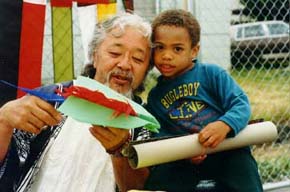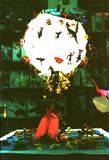
|

|
A man of contradictions and strong emotions, Makuuchi rejected his father's family name and has taken his mother's; yet his book is laced with wise and sardonic "Dad sez" aphorisms and his father's voice and presence pervade the text. The Camp Image section is particularly strong, filled with many unforgettable images: nightmarish writhing, skinned rattlesnakes; mischievous boys pushing out plywood knots to create peepholes; the author's sister climbing the (machine gun, ed.) tower ladders and jumping recklessly...

|
|
In addition to wordsmithing, Munio is a remarkable artist
with line, shadow and light, and he creates masterpieces of birds, planes
and animals with only scissors and paper. Munio Makuuchi is an original,
a survivor, and a valuable verbal/visual Asian American artist.
Amy Ling,
Director Asian American Studies Program
University of Wisconsin
Madison, Wisconsin
July 1993
|
|
|
This metaphor of cyclic steadfastness, which we can also take for a metaphor of the artist's own stubborn stance towards life, against accomodation and against conformity, even against apocalypse, shows a primitive sense of transformation. Unconcerned with propriety, decorum, and the forms that make up "civilization" (in the Western European sense), Munio has spent a lifetime fixated not just on but in the world of his childhood trauma, and whatever he has learned or experienced in later life has been recast back into the metaphors of his youth. Thus, his drawing is adamantly childish and childlike. One might take some of his young girls' faces to have Keane's pathetic and commercial features, but instead they are like Japanese or Chinese school books from before the War, printed on rough yellow newsprint in broken blocklines, half cartoon and half Asian pulp. He has never tried, nor seems he to want to try, to polish his drawing in the European tradition, always insisting on a crudity of form and technique, smudging his images, crumpling his paper, and overbiting his plates, all in favor of the energy of a primitive symbolism.
|
|
|
Yet, an M.A. in Printmaking, an M.F.A. in Painting, and years of university teaching do not make a primitive artist. Somehow, mysteriously, Munio has remained essentially untouched by culture. He is like a man who has fallen through the cracks. In spite of his education, he is self-taught, just as he is Japanese in spite of being American and American in spite of being Japanese, rejected by both cultures yet embracing them both while being neither. Somewhere in the hollows of this space, he has found, and is finding, a gifted way of existence.
Max Yeh
September 7, 1995

|
Munio's Home
Camp
| Aerogami
| Autobio/Graphics
| At Large
What's New?
| Letters to Ground Zero
| Info
| Virtual Cafe
DPNimages Project Page
Visit our independent friends at Four Seasons. This link has expired.
Visit the Mining Company for fine arts resources on the web. This link has expired.
All Contents except where specified are copyright ©
1986-1996 Munio Makuuchi, including the term "Aerogami"
All photographs except where specified are copyright © 1996 Josef LaVigne
Last updated 5/2/1998
This site designed and maintained by Josef LaVigne This link has expired.